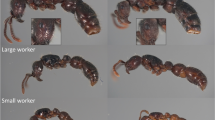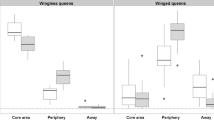Abstract
In many ants, young queens disperse by flying away from their natal nest and found new colonies alone (independent colony founding, ICF). Alternatively, in some species, ICF was replaced by colony fission, in which young queens accompanied by workers found a new colony at walking distance from the mother nest. We compared the queen morphology of Cataglyphis floricola, which disperses by fission, with that of its most likely living ancestor, Cataglyphis emmae, which disperses by ICF. As in other species, the transition from ICF to fission is associated with queen miniaturization. Interestingly, C. floricola presents two types of small queens: brachypters (with short non-functional wings) and ergatoids (worker-like apterous queens). Ergatoids are, on average, 2.8 mg lighter and have half the number of ovarioles than brachypters, which limits the advantage for a colony to produce ergatoids instead of brachypters. Furthermore, more ergatoids are produced than brachypters, but their individual survival rate is lower. During colony fission, 96% of the cocoons containing brachypters but only 31% of those containing ergatoids are transferred to the daughter nests where, after emergence, they compete for becoming the next queen. The remaining queen cocoons, which stay in the mother queen's nest, are eliminated by workers upon emergence, probably to maintain monogyny. This waste of energy suggests that producing ergatoids instead of brachypters is unlikely to increase colony efficiency. We argue that the evolution of ergatoids could derive from a selfish larval strategy, developing into worker-like queens in spite of the colony interest.



Similar content being viewed by others
References
Adams ES, Tschinkel WR (2001) Mechanisms of population regulation in the fire ant Solenopsis invicta: an experimental study. J Anim Ecol 70:355–369
Aron S, Passera L, Keller L (1999) Evolution of social parasitism in ants: size of sexuals, sex ratio and mechanisms of caste determination. Proc R Soc Lond B 266:173–177
Billen J (2009) Occurrence and structural organization of the exocrine glands in the legs of ants. Arthropod Struct Dev 38:2–15
Bolton B (1986) Apterous females and shift of dispersal strategy in the Monomorium salomonis-group (Hymenoptera: Formicidae). J Nat Hist 20:267–272
Bolton B, Marsh AC (1989) The Afrotropical thermophilic ant genus Ocymyrmex (Hymenoptera: Formicidae). J Nat Hist 23:1267–1308
Boulay R, Cerdá X, Simon T, Roldan M, Hefetz A (2007) Intraspecific competition in the carpenter ant Camponotus cruentatus: should we expect the dear enemy effect? Anim Behav 74:985–993
Boulay R, Cerdá X, Fertin A, Ichinose K, Lenoir A (2009) Brood development into sexual females depends on the presence of a queen but not on temperature in an ant dispersing by colony fission, Aphaenogaster senilis. Ecol Entomol 34:595–602
Bourke AFG, Ratnieks FLW (1999) Kin conflict over determination in social hymenoptera. Behav Ecol Sociobiol 46:287–297
Briese DT (1983) Different modes of reproductive behavior (including a description of colony fission) in a species of Chelaner (Hymenoptera: Formicidae). Insect Soc 30:308–316
Bullock JM, Kenward RE, Hails RS (2002) Dispersal ecology. Blackwell Science, Malden
Cerdá X, Retana J (2000) Alternative strategies by thermophilic ants to cope with extreme heat: individual versus colony level traits. Oikos 89:155–163
Chéron B, Doums C, Federici P, Monnin T (2009) Queen replacement in the monogynous ant Aphaenogaster senilis: supernumerary queens as life insurance. Anim Behav 78:1317–1325
Clémencet J, Cournault L, Odent A, Doums C (2010) Worker thermal tolerance in the thermophilic ant Cataglyphis cursor (Hymenoptera, Formicidae). Insect Soc 57:11–15
Clobert J, Danchin E, Dhondt AA, Nichols JD (2001) Dispersal. Oxford University Press, New York
Cronin A, Monnin T (2009) Bourgeois queens and high stakes games in the ant Aphaenogaster senilis. Front Zool 6:24
Délye G (1968) Recherches sur l'écologie, la physiologie et l'éthologie des fourmis du Sahara. In. Doctoral diss., Université d'Aix-Marseille
R Development Core Team (2010) R: A language and environment for statistical computing. R Foundation for Statistical Computing, Vienna, Austria. ISBN 3-900051-07-0. http://www.R-project.org. Accessed 16 Dec 2010
Dingle H, Holyoak M (2001) The evolutionary ecology of movement. In: Fox C, Roff DA, Fairbairn DJ (eds) Evolutionary ecology. Oxford University Press, New York, pp 247–261
Fernández-Escudero I, Seppä P, Pamilo P (2001) Dependent colony founding in the ant Proformica longiseta. Insect Soc 48:80–82
Foitzik S, Kureck IM, Ruger MH, Metzler D (2010) Alternative reproductive tactics and the impact of local competition on sex ratios in the ant Hypoponera opacior. Behav Ecol Sociobiol 64:1641–1654
Forel A (1909) Études myrmécologiques en 1909. Fourmis de Barbarie et de Ceylan. Nidification des Polyrhachis. Bull Soc Vaud Sci Nat 45:369–407
Gordon DM, Kulig A (1998) The effect of neighbours on the mortality of harvester ant colonies. J Anim Ecol 67:141–148
Hawkes C (2009) Linking movement behaviour, dispersal and population processes: is individual variation a key? J Anim Ecol 78:894–90
Heinze J (1989) Alternative dispersal strategies in a North American ant. Naturwissenschaften 76:477–478
Heinze J (1998) Intercastes, intermorphs, and ergatoid queens: who is who in ant reproduction? Insect Soc 45:113–124
Heinze J, Hölldobler B, Cover SP (1992) Queen polymorphism in the North American harvester ant, Ephebomyrmex imberbiculus. Insect Soc 39:267–273
Hölldobler B, Haskins CP (1977) Sexual calling behavior in primitive ants. Science 195:793–794
Hora RR, Doums C, Poteauc C, Fénéron R, Valenzuela J, Heinze J, Fresneau D (2005) Small queens in the ant Ectatomma tuberculatum: a new case of social parasitism. Behav Ecol Sociobiol 59:285–292
Howard KJ (2006) Three queen morphs with alternative nest-founding behaviors in the ant, Temnothorax longispinosus. Insect Soc 53:480–488
Jarau S, Van Veen JW, Twele R, Reichle C, Herrera Gonzales E, Aguilar I, Francke W, Ayasse M (2010) Workers make the queens in Melipona bees: identification of geraniol as a caste determining compound from labial glands of nurse bees. J Chem Ecol 36:565–569
Keller L, Passera L (1989) Size and fat-content of gynes in relation to the mode of colony founding in ants (Hymenoptera, Formicidae). Oecologia 80:236–240
Keller L, Reeve HK (1999) Dynamics of conflicts within insect societies. In: Keller L (ed) Levels of selection in evolution. Princton University Press, Princeton, pp 153–175
Lachaud JP, Cadena A, Schatz B, Pérez-Lachaud G, Ibarra-Núñez G (1999) Queen dimorphism and reproductive capacity in the ponerine ant, Ectatomma ruidum Roger. Oecologia 120:515–523
Leal IR, Oliveira PS (1995) Behavioral ecology of the neotropical termite-hunting ant Pachycondyla (=Termitopone) marginata: colony founding, group-raiding and migratory patterns. Behav Ecol Sociobiol 37:373–383
Lenoir A, Querard L, Pondicq N, Berton F (1988) Reproduction and dispersal in the ant Cataglyphis cursor (Hymenoptera, Formicidae). Psyche 95:21–44
Molet M, Peeters C, Fischer B (2007a) Winged queens replaced by reproductives smaller than workers in Mystrium ants. Naturwissenschaften 94:280–287
Molet M, Peeters C, Fisher BL (2007b) Permanent loss of wings in queens of the ant Odontomachus coquereli from Madagascar. Insect Soc 54:183–188
Molet M, Van Baalen M, Peeters C (2008) Shift in colonial reproductive strategy associated with a tropical-temperate gradient in Rhytidoponera ants. Am Nat 172:75–87
Nonacs P, Tobin JE (1992) Selfish larvae: development and the evolution of parasitic behavior in the Hymenoptera. Evolution 46:1605–1620
Pamilo P (1991) Evolution of colony characteristics in social insects, I. Sex allocation. Am Nat 137:83–107
Passera L, Keller L (1990) Loss of mating flight and shift in the pattern of carbohydrate storage in sexuals of ants (Hymenoptera, Formicidae). J Comp Physiol B 160:207–211
Peeters C (1991) Ergatoid queens and intercastes in ants: two distinct adult forms which look morphologically intermediate between workers and winged queens. Insect Soc 38:1–15
Peeters C, Ito F (2001) Colony dispersal and the evolution of queen morphology in social Hymenoptera. Ann Rev Entomol 46:601–630
Peeters C, Molet M (2009) Colonial reproduction and life histories. In: Lach L, Parr C, Abbott K (eds) Ant ecology. Oxford University Press, Oxford, pp 161–178
Ratnieks FLW (2001) Heirs and spares: caste conflict and excess queen production in Melipona bees. Behav Ecol Sociobiol 50:467–473
Roff DA (1990) The evolution of flightlessness in insects. Ecol Monogr 60:389–421
Schwander T, Lo N, Beekman M, Oldroyd BP, Keller L (2010) Nature versus nurture in social insect caste differentiation. Trends Ecol Evol 25:275–282
Seeley T (1995) The wisdom of the hive: the social physiology of honey bee colonies. Harvard University Press, Cambridge
Tinaut A (1993) Cataglyphis floricola nov. sp. new species for the genus Cataglyphis Förster, 1850 (Hymenoptera, Formicidae) in the Iberian Peninsula. Mitt Schweiz Entomol Ges 66:123–134
Tinaut A, Ruano F (1992) Braquipterismo y apterismo en formícidos. Morfología y biometría en las hembras de especies ibéricas de vida libre (Hymenoptera: Formicidae). Graellsia 48:121–131
Van Dyck H, Baguette M (2005) Dispersal behavior in fragmented landscapes: routine or special movements. Bas App Ecol 6:535–545
Wenseleers T, Ratnieks FLW (2004) Tragedy of the commons in Melipona bees. Proc R Soc B 271:S310–S312
Wenseleers T, Ratnieks FL, Billen J (2003) Caste fate conflict in swarm-founding social Hymenoptera: an inclusive fitness analysis. J Evol Biol 16:647–658
Wenseleers T, Ratnieks FLW, MdF R, DdA A, Imperatriz-Fonseca VL (2005) Working-class royalty: bees beat the caste system. Biol Lett 1:125–128
Wiernasz DC, Cole BJ (1995) Spatial distribution of Pogonomyrmex occidentalis: recruitment, mortality and overdispersion. J Anim Ecol 64:519–527
Wiernasz DC, Cole BJ (2003) Queen size mediates queen survival and colony fitness in harvester ants. Evolution 57:2179–2183
Acknowledgments
We thank D. Aragonés, Á. Barroso, A. Carvajal, T. Cerdá, M.Á Cobo, J. Melgar, L. Sinde, and C. Ruel for their help in the field and C. Vaquero for her assistance with the MEB. We are also grateful to C. Peeters, T. Wenseleers, T. Monnin, P. Nonacs, J. Pearce, and an anonymous referee for their helpful comments throughout this work. Jacqueline Minett assisted us with English editing. This project was funded by grants CGL2009-12472, CGL2006-04968, and CGL2009-09690 from the Spanish Ministerio de Ciencia e Innovación and Feder (for RB, XC, and AL). We thank the authority of the Doñana National Park for permitting access to research installations.
Author information
Authors and Affiliations
Corresponding author
Additional information
Communicated by L. Keller
Electronic supplementary material
Below is the link to the electronic supplementary material.
ESM 1
(8.10 204 mb)
Rights and permissions
About this article
Cite this article
Amor, F., Ortega, P., Jowers, M.J. et al. The evolution of worker–queen polymorphism in Cataglyphis ants: interplay between individual- and colony-level selections. Behav Ecol Sociobiol 65, 1473–1482 (2011). https://doi.org/10.1007/s00265-011-1157-7
Received:
Revised:
Accepted:
Published:
Issue Date:
DOI: https://doi.org/10.1007/s00265-011-1157-7




